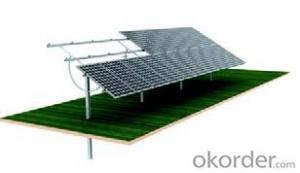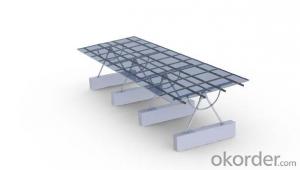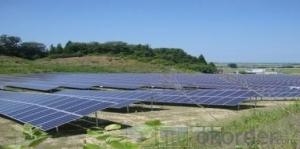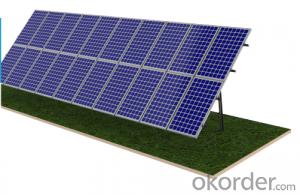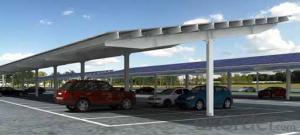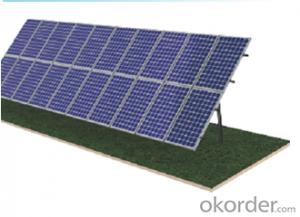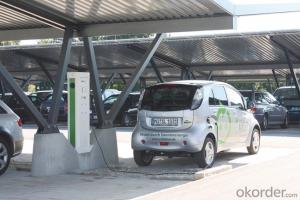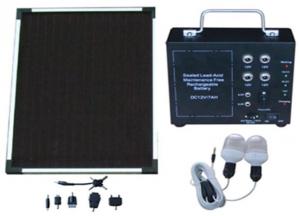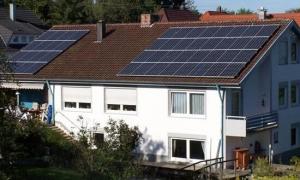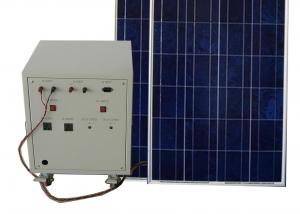Solar Energy Systems Lancaster Single Pile Manual Solar Mounting System
- Loading Port:
- China Main Port
- Payment Terms:
- TT OR LC
- Min Order Qty:
- -
- Supply Capability:
- -
OKorder Service Pledge
OKorder Financial Service
You Might Also Like
Packaging & Delivery
Packaging Detail:Normal package seaworthy
Delivery Detail:15 days
Specifications
Easy installation Competitive price TUV&SGS test report & CSA certification 15-warranty
Specifications
1) Super smooth beautiful appearance,outstanding quality,large supply.
2) Available in customized surface finishes.
3) Well machined,for example,cutting,drilling and milling with excellent tolerance.
4) Meet with customer’s designs and supply you best price.
5)Usages:Supply for solar panel modules.
Technical characteristics
Installation site:
ground,hillside,and grassland
Installation angle
it is based on customers’ requirements
Installation height
it is basedon customers’ requirements
Solar panel type; with or without frame
Components arrangement :horizontal or vertical
Support track
aluminum alloy extrusion
Quality warranty
15 years
Advantages
1)Quick installation: with high degree of pre-installed rate, the system could be easily installed by using galvanized carbon steel rails for PV Stent, and specially designed connection parts of the PV bracket, which could reduce installation time and cost greatly.
2)Offer unmatched durability: with all structural components comprised of high class stainless steel and anodized aluminum alloy, it is designed for 25 years service life and backed by 15 years warranty.
3)Stand up to extreme weather: The SuninTek solar mount is designed to stand up to the extreme weather complied with the AS/NZ 1170 and other international structure load standard by the skilled engineer. The main support components also have been tested to guarantee its structure and load-carrying capacity.
4)Provide broad installation flexibility: These systems accommodate most commercially available framed solar panels , and they can scale easily from small to large, multi-megawatt installations.
5)Diversified Application: The PV mounting system produced can be adopted by various types of PV cells panels which you can find in the market. It can serve for both mini solar power system and huge plant with megawatt capability.
Main features
1. Installation cost savings.
2. Save installation time.
3. Increase the mechanical strength of solar energy mounting to ensure that wind requirements.
4. The outdoor for installation of solar energy.
5. Length can be customized according to customers.
6. Service life of up to 25 years.
7. Products through the international certification.
8. Stent material composition of the galvanized steel and aluminum.
9. 15 years system and structural guarantee.
10.Flexible post spacing withstands different wind & snow loads.
11. High quality material in Aluminium 6005-T5 and SUS 304.
12.Screws and nuts go with every components needed.
13.Mechanical calculation and reliability tested to ensure highest product quality.
- Q: Can a solar energy system be installed in an area with high wind speeds?
- Yes, a solar energy system can be installed in an area with high wind speeds. However, it is essential to consider the wind load requirements and design the system accordingly to ensure its stability and durability in such conditions. This may involve using specialized mounting systems, robust materials, and proper anchoring methods to withstand the impact of strong winds and prevent any damage to the system.
- Q: Can solar energy systems be used in areas with strict building codes or historical preservation restrictions?
- Indeed, it is possible to utilize solar energy systems in areas that have stringent building codes or restrictions on historical preservation. Although it may necessitate additional considerations and careful planning, integrating solar energy systems into the existing structures is certainly achievable. One approach to incorporating solar energy systems involves employing building-integrated photovoltaics (BIPV) or solar thermal systems that flawlessly blend into the building's design. These systems can be installed on rooftops, facades, or even utilized as shading elements, ensuring that the building's historical aesthetics or architectural integrity remain intact. Additionally, advancements in solar technology have facilitated the creation of more visually appealing solar panels, such as solar tiles or transparent solar windows, which harmonize with the building's existing materials. This simplifies the process of obtaining approval from historical preservation boards or building code authorities. It is crucial to note that in areas with strict building codes or historical preservation restrictions, the approval process for installing solar energy systems may be more complex. It may entail acquiring permits, conducting structural assessments, and closely collaborating with local authorities to ensure compliance with regulations. Nevertheless, due to the increasing recognition of the significance of renewable energy, many jurisdictions have established specific guidelines and provisions for integrating solar systems in historic areas. To summarize, it is feasible to utilize solar energy systems in areas with strict building codes or historical preservation restrictions by employing BIPV, solar thermal systems, or visually appealing solar panels. Although the approval process may require more effort, with proper planning and adherence to guidelines, it is possible to harness solar energy without compromising the architectural or historical significance of the area.
- Q: Can solar energy systems be used for wastewater treatment?
- Yes, solar energy systems can be used for wastewater treatment. Solar energy can power various components of a wastewater treatment system, such as pumps, aerators, and disinfection units, reducing or eliminating the need for grid electricity. Solar-powered wastewater treatment systems are not only environmentally friendly but also cost-effective, making them a sustainable solution for remote or off-grid areas where traditional infrastructure is not readily available.
- Q: Can solar energy systems be installed on recreational vehicles?
- Yes, solar energy systems can be installed on recreational vehicles.
- Q: What is net metering and how does it work with solar energy systems?
- Net metering is a billing arrangement that allows solar energy system owners to receive credit for the excess electricity they generate and feed back into the grid. With net metering, a bi-directional meter is installed, which measures both the electricity consumed from the grid and the excess electricity generated by the solar system. This excess electricity is then credited to the owner's account, effectively offsetting their future electricity consumption. When the solar system produces more electricity than is consumed, the surplus is fed back into the grid, and the owner receives credits for it. These credits can be used to offset the electricity consumed during periods when the solar system is not generating enough power, such as at night or during cloudy days. Overall, net metering allows solar energy system owners to maximize their investment by ensuring they benefit from the excess electricity they generate.
- Q: Can solar energy systems be used for outdoor recreational activities?
- Yes, solar energy systems can definitely be used for outdoor recreational activities. Solar panels can be installed on rooftops, RVs, boats, and other outdoor structures to generate electricity. This renewable energy source can power various devices and equipment used during recreational activities such as camping, hiking, and boating. Solar energy systems provide a sustainable and environmentally friendly way to enjoy outdoor activities without relying on traditional power sources.
- Q: Can solar panels be installed on RVs or boats?
- Solar panels can be installed on both RVs and boats, offering a sustainable and efficient way to generate electricity while on the move. These panels are increasingly popular and provide a reliable power source for various appliances and equipment used in RVs and boats, including lights, fans, refrigerators, and electronic devices. Typically mounted on the roof or deck, the panels capture sunlight and convert it into usable energy. This enables RV and boat owners to decrease their reliance on traditional power sources, granting them the freedom to explore remote areas without the need for electrical hookups. Furthermore, solar panels on RVs and boats contribute to environmental preservation by reducing carbon emissions. Nevertheless, it is crucial to consider power requirements and available space before installation, as well as ensuring proper maintenance and installation for optimal efficiency and durability.
- Q: Can solar energy systems be used in areas with limited access to solar energy equipment suppliers?
- Yes, solar energy systems can still be used in areas with limited access to solar energy equipment suppliers. While it may be more challenging to obtain the necessary equipment, it is still possible to install and maintain solar energy systems in such areas. Additionally, advancements in technology and the availability of online marketplaces make it easier for remote areas to access solar energy equipment. Moreover, local communities can also explore partnerships or collaborations with nearby regions or organizations to ensure a sustainable supply of solar energy equipment in the long run.
- Q: How long does it take to install a solar energy system?
- The time it takes to install a solar energy system can vary depending on various factors such as the size of the system, the complexity of the installation, and the availability of resources. However, on average, a typical residential solar energy system can be installed within a few days to a few weeks.
- Q: What is the impact of snow on the performance of solar panels?
- The performance of solar panels can be significantly affected by snow. When snow covers the panels, it hinders sunlight from reaching the photovoltaic cells, thus decreasing their efficiency in generating electricity. This can lead to a significant reduction or even a complete halt in the electricity output during heavy snowfall. Snow accumulation on solar panels also adds extra weight and has the potential to cause damage if the panels are not designed to withstand heavy loads. Moreover, the presence of snow on the panels' surface can cause uneven melting, resulting in water seepage that may damage the electrical components. To address the impact of snow on solar panels, various strategies can be implemented. One common approach is to install the panels at an angle that facilitates the easy sliding off of snow. Additionally, some panels are equipped with special coatings or materials that prevent snow from adhering to the surface. Heating elements can also be integrated into the panels to melt the snow and prevent accumulation. In conclusion, while snow can present challenges for solar panels, proper design, installation, and maintenance can minimize the impact and ensure optimal performance even in snowy conditions.
Send your message to us
Solar Energy Systems Lancaster Single Pile Manual Solar Mounting System
- Loading Port:
- China Main Port
- Payment Terms:
- TT OR LC
- Min Order Qty:
- -
- Supply Capability:
- -
OKorder Service Pledge
OKorder Financial Service
Similar products
Hot products
Hot Searches
Related keywords
